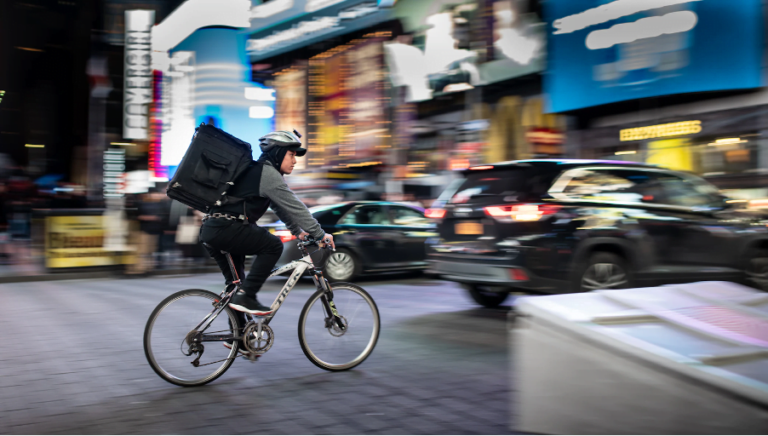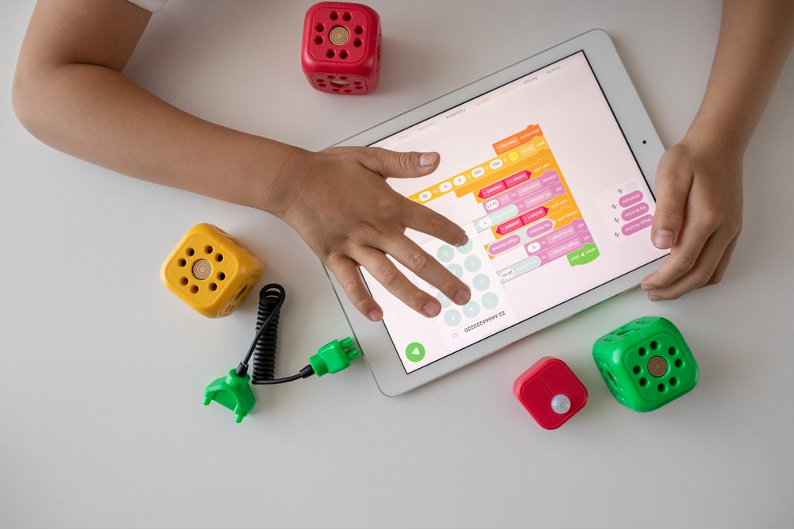Main Menu


Robot food delivery is can help the environment. Dr. Ali Kashani estimates that if we could get rid of food deliveries by car, we could get 1.5 million cars off the road.
Did you catch Dr. Ali Kashani’s awesome STEM education talk at EduDrone 2020? He gave us a glimpse into the future of robot food delivery, and spoke about the importance of designing robots that are inclusive, and can speak universal human body language.
Missed it? Don’t stress! Each month in the lead up to EduDrone 2021, we’ll be releasing one of our favourite talks from EduDrone 2020! Tune in each month to get your fix of STEM-spiration. We hope this will keep the ideas flowing all the way through until EduDrone 2021!

Have you ever ordered food through an online delivery service, like UberEats, Deliveroo, or Menulog? How was it delivered? On foot? Bike? Scooter? Or car? Although many food delivery services are diversifying their fleet, the majority of deliveries are still made by car.
The statistics in the USA are staggering. In 2018, every single day there were 20 million restaurant deliveries – 90% of these were done using cars, but over half of them were within walking distance. This means we use a 2-tonne car to move a 2-pound burrito 20 million times a day.
Dr. Ali Kashani estimates that if we could get rid of food deliveries by car, we could get 1.5 million cars off the road.
So, what can we use instead of cars? Drones? We love drones at She Maps, but Ali made a pretty good point that when it comes to robots, “it’s easier to roll with gravity than to defy it every day.”
There’s a reason that the wheel was invented 5,000 years ago, whereas it’s only in the last century that humans have been able to make wings and fly. But using land-based robots for food deliveries poses unique challenges. They have to be able to navigate tricky terrain, avoid obstacles, and interact with humans from all walks of life.
This is where Ali comes in.
He works for a company called Postmates, who are developing robots with artificial intelligence (AI) that can navigate human cities.
Ali and his team have created a robot that is designed to move small objects across small distance (a couple of kms). It’s electrically powered, moves at walking speed, can go all day on a single charge, and can move two big shopping bags. How convenient, right? That alone is a good enough reason to introduce geospatial science for schools to your students.
When many people think of robots roaming the streets, they have visions of a dystopian Hollywood future. So, another challenge that Ali faced was how to make the robots appear fun and friendly, to change people’s mind about STEM education and technology.
To do this, first impressions are everything!
Ali wanted to build robots that were familiar, and wouldn’t look strange in the environment. So, he designed them to look like a baby stroller/shopping cart, which belongs on the sidewalk, but at the same time surprising and fresh. Ali says his robots are designed to look like a cross between Wall-E and the Minions.
Here’s a good project idea to add to your STEM curriculum.
When designing food delivery robots, one of the most important things Ali needs to think about is who they will interact with. They will be travelling down the street, encountering and interacting with humans. These people may come from any background, speak different languages, and have different education levels. They also may not know much about technology, and they won’t have read the user manual! To get around this, Ali gives the robot a language that is universal – body language!
If the robot encounters someone along the footpath who is using a wheelchair, the robot needs to yield to them, but it also needs to communicate with them to let them know that it will stay out of their way until they pass. It can’t use words (as the person may not know English), and a display may not be visible from long distances or in bright sunlight. So instead, the robot moves and points itself away from the sidewalk to show that it is clearing the path for the person in a wheelchair.
Once these robots become widely accepted by society, Ali imagines how we can utilise them for many different things, not just food delivery. In busy cities, paramedics can take up to 7-10 minutes to respond. However, if you have robots doing food deliveries all over the city, a robot could divert itself and show up in 30-60 seconds. They can carry emergency medication, such as an EpiPen, and could show up quickly in a time of crisis. These technological advancements could inspire students to take up STEM education for secondary schools and help them forge the path to becoming future robotic engineers.

Another use is food waste. In the developed world approximately 30% of food is wasted even though 10% of the population experiences food insecurity. Ali imagines a world where robots, at the end of their shifts, could go to restaurants, pick up excess food that was about to be discarded, and take them to shelters and other places that need them.
Apart from food-related applications, drones can also be used for agri-tech learning and crop monitoring, as demonstrated by agricultural expert Jade King.
This future is possible, and just around the corner, when we embrace a new urban infrastructure for our cities and start teaching STEM in schools.
When Ali was in grade six, his school drove a bus load of students 45 minutes to get to a computer lab so that they could attend a programming class. This was a life-changing experience for him, and Ali loved programming so much that he became obsessed with it. He would painstakingly write out code on a piece of paper (he didn’t have a computer), and then type it into the computer in the school staff room to see if it would work.
Fast-forward twenty years and Ali is now creating cutting edge robots, teaching them body language, and giving epic Ted talks. The world has changed so much in his lifetime, and he is incredibly excited to see what this coming generation will be capable of.
“Nowadays there are so many tools that kids can access to learn about programming, robots, and drones,” he says. “That is such an exciting thing for the future because we have incredible talent just around the corner that will be entering the workforce in a few years.”
As educators of STEM in secondary schools, we have the responsibility of developing the next generation of makers and creators. We should be encouraging them to utilize the technology at their fingertips as an opportunity to solve big problems in the world and make it a better place.
Want to help your students succeed through STEM geography? Check out some tips from another EduDrone guest speaker Brett Dascombe here.

Check out Ali’s full EduDrone 2020 presentation below!
She Maps is Australia’s leading expert in drone and geospatial education.
She Maps assist schools with the purchasing of drones, school-industry created drone and geospatial teaching resources and highly supportive teacher professional development.
Ready to buy drones for your school? We are an authorised DJI reseller in Australia

Subscribe by email and never miss a blog post or announcement.

She Maps aims to bring much needed diversity and support to STEM. We do this by providing drone and geospatial programs to teachers and schools across the globe.
At She Maps we acknowledge the Traditional Custodians of Country throughout Australia and their connections to land, sea, and community. We pay our respect to their Elders past and present and extend that respect to all Aboriginal and Torres Strait Islander peoples today.
Aboriginal and Torres Strait Islander peoples are advised that this site may contain names, voices, or images of people who have passed away.
Learn the 6 Steps to Launching a Successful Drone and Geospatial Program at your School
Take our resources for a spin and join the thousands of teachers who love our ready-to-teach classroom materials. Try one of our complete units of work for free.

